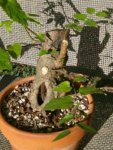Melospiza
Shohin
I believe this is a Georgia Hackberry (Celtis tennuifolia) and not a Southern Hackberry/Sugarberry. My neighbour had cut down the top of this tree and it was sprouting from the cut. I air-layered it to include a natural hollow. Right now, it is recovering in a pot, and I plant to work on the roots and carving the top next year. Maybe drill into the dead top of the tree to connect it to the uro?










